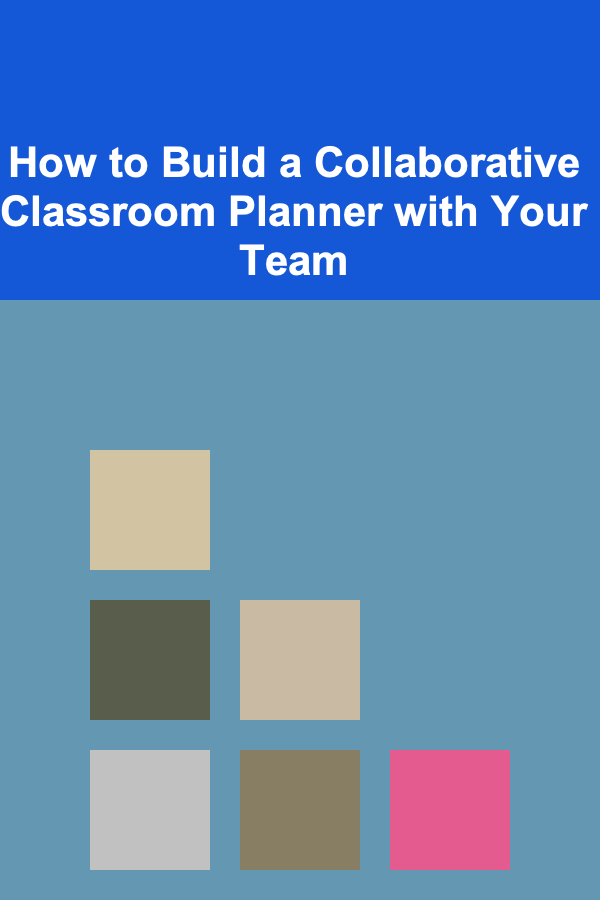
How to Build a Collaborative Classroom Planner with Your Team
ebook include PDF & Audio bundle (Micro Guide)
$12.99$8.99
Limited Time Offer! Order within the next:

Building a collaborative classroom planner with your teaching team can significantly improve the efficiency and cohesiveness of your classroom environment. Whether you're working with a group of teachers, teaching assistants, or other educational professionals, a well-designed planner can enhance communication, streamline lesson planning, and ensure that all involved parties are aligned on classroom objectives. In this comprehensive guide, we'll explore the steps to create an effective collaborative classroom planner that can help you and your team manage classroom activities, track progress, and ultimately foster a more dynamic and effective learning environment.
Understand the Purpose and Benefits of a Collaborative Planner
Before diving into the creation of a collaborative classroom planner, it's essential to understand why it's important. A collaborative planner offers several key benefits for both teachers and students:
Enhanced Communication
A shared planner ensures that all members of the teaching team are on the same page. It fosters communication and transparency, ensuring that everyone knows the goals and focus for the week, month, or term.
Improved Consistency
Having a collaborative approach to planning ensures consistency across the classroom. Whether you're teaching different subjects or working with multiple grade levels, consistent strategies and objectives lead to a more cohesive learning experience for the students.
Better Tracking and Documentation
A collaborative planner can help track lesson progress, assess student needs, and document the decisions and changes made throughout the term. This is especially useful for reflecting on past lessons and making improvements for the future.
Shared Responsibility
By involving all team members in the planning process, you distribute the responsibility of lesson creation, classroom management, and student engagement. This shared responsibility leads to a sense of ownership and greater investment in the teaching process.
Choose a Platform for Collaboration
The first step in building a collaborative classroom planner is choosing the right platform or tool. Depending on your team's preferences and available resources, there are several options available for online collaboration:
Google Docs/Sheets
Google Docs or Google Sheets can be a great choice for creating and sharing your classroom planner. They allow for real-time collaboration, and all changes are automatically saved. You can create separate tabs for lesson planning, classroom schedules, student progress tracking, and more.
Trello
Trello is a flexible project management tool that allows you to create boards, lists, and cards. Teachers can use Trello to organize lesson plans, assign tasks to team members, track student progress, and monitor classroom activities. It's visually intuitive, making it easy to stay organized.
Microsoft OneNote
OneNote is an excellent platform for creating collaborative notebooks. You can create sections and pages to store lesson plans, resources, and notes from team meetings. Its collaborative features allow multiple team members to work simultaneously on the same notebook.
Asana
Asana is another project management tool that can help with collaborative planning. It allows you to create tasks, set deadlines, and assign responsibilities to different team members. You can create project boards for different subjects or classes, ensuring that everything is organized.
Offline Tools (Paper Planners)
If your team prefers a more traditional approach, you could opt for printed planners and binders. While this eliminates the convenience of online collaboration, some teams find that working with physical materials encourages creativity and clearer communication. You can create templates that include sections for lessons, goals, and notes, and distribute them to each team member.
Define Roles and Responsibilities
Before beginning the planning process, it's crucial to establish roles and responsibilities within your team. Having clear expectations helps ensure that everyone is accountable and knows their specific contributions. Here are some common roles that might be involved in the planning process:
Lead Teacher
The lead teacher usually takes on the responsibility of overseeing the entire classroom planner, ensuring that all lesson plans are aligned with curriculum objectives. They may also be the person to review the planner before sharing it with the team.
Subject Specialists
If your team consists of subject-specific teachers, each specialist can focus on creating and managing lessons for their specific area. For instance, a math teacher may handle the math lessons, while an English teacher handles language arts.
Teaching Assistants
Teaching assistants can help with organizing the planner and may take on tasks such as preparing materials, tracking student behavior, or assisting with classroom management during specific lessons.
Additional Educational Professionals
Sometimes, school counselors, speech therapists, or special education teachers are involved in the planning process. Their input ensures that the needs of all students, including those with special needs, are addressed in the classroom.
Establish Clear Objectives and Goals
Before planning any lessons, it's essential to align on the educational objectives and goals for the students. These should be determined at the beginning of each semester or term and revisited as needed. Here are some questions to guide your goal-setting process:
What are the learning outcomes for the term?
Identify the key skills and knowledge that students should acquire by the end of the term. These will guide the content you include in your lessons.
How will you assess student progress?
Establish the methods you'll use to assess student progress. Will you use quizzes, projects, presentations, or formative assessments?
What are the classroom management goals?
Plan for how you'll manage classroom behavior, encourage engagement, and create a positive classroom culture. This could include strategies for student collaboration, individual accountability, and motivation.
Collaborate on Lesson Plans
Once roles and responsibilities are defined and goals are set, the next step is creating the actual lesson plans. Here's how to collaborate effectively on lesson planning:
Share Templates and Frameworks
Start by sharing a lesson plan template that all team members can use. This ensures that each lesson has the same structure, making it easier to compare and track progress. The template should include sections for:
- Objectives
- Materials
- Teaching strategies
- Assessment methods
- Student accommodations
By using a consistent format, you can ensure that all lessons align with your classroom goals and make it easier for the team to follow.
Co-Create Lesson Plans
Work together on drafting the lessons for the upcoming weeks. Each team member can contribute by adding their area of expertise. For instance, one teacher might focus on lesson content, while another might suggest ways to incorporate technology or hands-on activities. If a lesson requires collaboration across subjects, make sure to coordinate the scheduling of joint lessons, projects, or cross-curricular activities.
Plan for Differentiation
One of the primary benefits of collaborative planning is that you can address the diverse needs of students more effectively. When creating lesson plans, ensure there are differentiated activities to accommodate various learning styles, abilities, and interests. Collaborate on ideas for scaffolding, extensions, and alternative assessments.
Incorporate Feedback and Reflection
After implementing lessons, it's crucial to revisit your planner and reflect on what worked well and what didn't. Regular feedback is essential for improving the quality of your teaching and ensuring the success of future lessons. You can do this by:
Hold Reflection Meetings
Set aside time at the end of each week or month to meet with your team and reflect on how things went. Discuss what strategies were successful, what challenges arose, and how you can improve your planning moving forward.
Collect Student Feedback
Engage students in providing feedback on the lessons and activities they've experienced. This could be done informally or through surveys. Student input will give you insights into what resonates with them and what they may need more help with.
Make Adjustments Based on Data
Use assessment data, classroom observations, and student feedback to make adjustments to your lesson plans. A collaborative planner allows you to track and analyze patterns over time, helping you make informed decisions about where to make improvements.
Keep the Planner Flexible
While structure is important, flexibility is equally crucial in a collaborative classroom planner. Unexpected changes can arise---whether it's a school event, a shift in the curriculum, or an unforeseen issue with a lesson. Keep the planner flexible enough to adapt to these changes while maintaining the integrity of your goals.
Regularly Update the Planner
Keep your planner up to date by adding new information as the term progresses. If lessons need to be adjusted due to external factors, make sure all team members are informed of the changes.
Make Use of Digital Tools for Easy Edits
If you're using a digital tool like Google Docs, Trello, or Asana, ensure that it's easy to make changes and notify team members of updates. This allows for quick adjustments without the risk of miscommunication.
Foster Team Collaboration Beyond Planning
Collaboration should extend beyond just lesson planning. To ensure the success of your classroom planner, consider the following:
Engage in Team-Building Activities
Strong relationships between teachers and educational staff are crucial for effective collaboration. Consider team-building activities to foster communication, trust, and camaraderie.
Share Resources
Encourage team members to share teaching resources such as worksheets, articles, and ideas for classroom activities. A shared resource pool can help reduce workload and improve the quality of your lessons.
By following these steps, you can build a collaborative classroom planner that benefits both your team and your students. The key to success is communication, organization, and flexibility, all of which are essential for fostering a positive, engaging, and productive learning environment.
Reading More From Our Other Websites
- [Home Lighting 101] How to Create Ambiance with Budget-Friendly Lighting
- [Organization Tip 101] How to Establish Boundaries Between Work and Personal Life in Your Workspace
- [Personal Finance Management 101] How to Save for a Down Payment on a House
- [Organization Tip 101] How to Use File Boxes for Important Documents
- [Home Space Saving 101] How to Save Space in Your Home by Using Furniture with Built-In Storage
- [Home Rental Property 101] How to Inspect and Ensure the Safety of a Storm Shelter in Rentals with a Storm Shelter Before and After Use
- [Horseback Riding Tip 101] Saddle Up for Strength: How Horseback Riding Boosts Full-Body Fitness
- [Personal Investment 101] How to Start a Side Hustle with Deep Learning for Passive Income
- [Beachcombing Tip 101] How to Leverage Drone Technology to Locate Optimal Beachcombing Zones
- [Home Security 101] How to Protect Your Home from Fire and Smoke Hazards

How to Increase Rental Income with Minor Renovations
Read More
How to Make a Festive Hot Cocoa Bar at Home
Read More
How to Soundproof Your Doors and Windows Without Replacing Them
Read More
Troubleshooting Zen: Quick Fixes and Best Practices for Tech Support
Read More
How to Use a Sales Planner for Seasonal Sales Promotions
Read More
How to Craft a Realistic New Year's Resolution To-Do List
Read MoreOther Products

How to Increase Rental Income with Minor Renovations
Read More
How to Make a Festive Hot Cocoa Bar at Home
Read More
How to Soundproof Your Doors and Windows Without Replacing Them
Read More
Troubleshooting Zen: Quick Fixes and Best Practices for Tech Support
Read More
How to Use a Sales Planner for Seasonal Sales Promotions
Read More